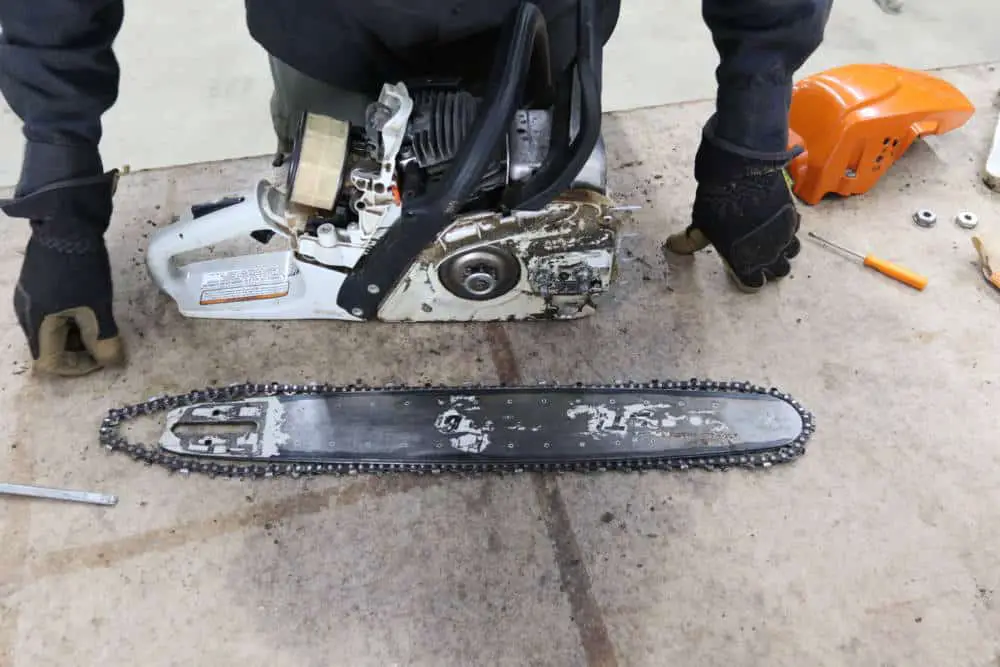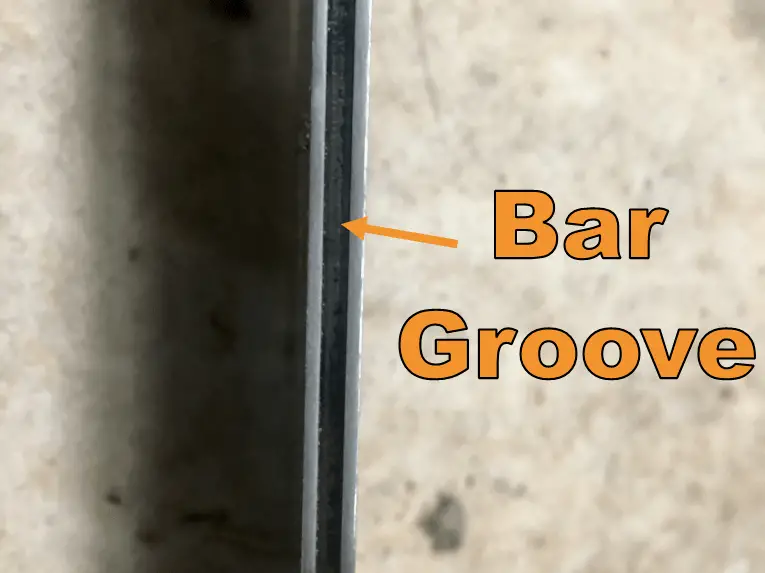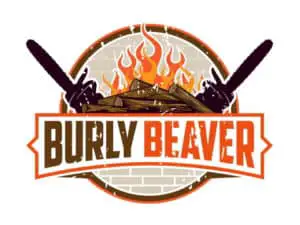
Looking to measure the length of your chainsaw guide bar? Whether you’re replacing your bar, or you just want to know the length of the maximum cut you can make, it’s a pretty simple process.
In a nutshell, here’s how to measure your chainsaw bar length:
Lay the chainsaw on its side, with the removable face plate facing up. Take a tape measure and measure the length of the exposed bar, from the chainsaw to the tip of the bar. Round to the nearest full number, and that’s the chainsaw bar length.
This measurement gives you the effective length of the bar, which is the number used for replacement bars. This will also tell you the maximum length cut you can make.
But don’t stop quite yet! There’s more to a bar than just it’s length. There are a total of 4 numbers that you need to properly size a chainsaw bar, and to ensure it is compatible with your chain.
We’ll dive into each one below, and by the end of this post you’ll have all the bar info you need!
The 4 bar numbers
There are 4 important numbers when it comes to chainsaw bars. In order to get a replacement bar that fits properly, it’s critical that all 4 of these numbers are correct. If 3 are right, but 1 is wrong, then the whole bar still won’t work.
Here’s a quick list:
- Bar length
- Gauge
- Pitch
- Chain length
Bar length we mentioned in the intro, but we’ll go into a little more detail using a real example below. Gauge, pitch and chain length are all important, because they determine whether a bar is compatible with a given chain.
There’s more you’ll want to know about each of these though, so let’s get to it!
1. Bar Length
Alright, let’s start with a quick recap of how to measure bar length, then we’ll use a real example from one of our chainsaws to make things crystal clear.
- Make sure the chainsaw is turned off
- Lay the chainsaw on its side (Note: put the side with bolts or auto crank facing up)
- Measure from the body of the chainsaw to the tip of the bar with a tape measure
- Round to the nearest full number
- Now you have your bar length!
The photo below shows the portion of the bar that you will need to measure to get the bar length.

This photo features our trusty 20+ year old Stihl MS250 chainsaw. The bar we have on it currently is rated as a 16 inch bar. If you measure from the chainsaw body, to the tip of the bar (as shown in the image), it’s actually about 15.5 inches long.
But, nobody sells bars labeled as 15.5 inches long. Instead, all manufacturers are going to call that a 16 inch bar. This is important to know, so you don’t get caught up on fractional differences when looking for a bar.
Tip: some manufacturers will stamp bar length into the information panel on the side of the bar. Check for this first, and you might save yourself the time of finding a tape measure.
You might also like to know, that what we’re measuring here is sometimes called the effective length of the bar. This is what “bar length” means to most people, and it’s also the number you’d use when buying a new bar, because manufacturers go by this number on their labels.
With that said, the full bar is actually longer than what we’re measuring, because it extends into the body of the chainsaw a couple of inches. If you removed the bar from the chainsaw, and then measured it end-to-end, that would give you the true length of the bar.
The true length is really only relevant as an interesting piece of chainsaw trivia, you’re not going to need to know it for purchasing or using a chainsaw bar.
Next, we’ll turn our attention to the gauge.
2. Gauge
The gauge is the width of the chain links, and as a result, it’s also the width of the groove that runs along the outside of the bar.
The wider the gauge of the chain links, the wider the groove on your bar has to be.
Here’s what it looks like.

And here’s where you find the gauge rating stamped on the side of a bar.

This one is pretty straightforward, and not too hard to find.
It’s super important though, because if the gauge is wrong, your chain won’t fit properly along the bar. This can cause a few problems. For example, if the gauge is too big you might throw your chain, which is both dangerous and inconvenient.
On the other hand, if your bar’s gauge is too small, then the chain probably won’t even fit.
If your bar is well loved and you can’t read the information stamp, there’s another way to do it and all you need is some change.
No seriously, just grab a quarter, dime, and penny. Each of these coins fits inside the bar track and represents a different gauge. The measurements break down like this.
Quarter = 0.063″
Penny = 0.058″
Dime = 0.050″
Alright, let’s look at pitch next.
3. Pitch
Pitch is a chain measurement, but you have to have a bar that matches.
If you want to get technical, pitch is measured as the total distance between 3 rivets, divided by 2. Don’t worry, you might never have to measure this yourself. But, if you do, we have the whole process laid out here.
Pitch can be found pretty easily on the side of the bar, within the information box.

If you’re replacing an old bar, just get a new bar that has the same pitch, and you’re good to go. Otherwise, you can match the bar to the pitch of a chain.
Next up is chain length, which is measured a bit differently than you might guess.
4. Chain Length
The length of a chainsaw chain is measured by links (not inches or cm).
For a bar, you can find the compatible chain length (in links) on the side.
Find compatible chain length on your bar:

You’ll have to excuse the faded text on this bar, it’s been well used 🙂
For chainsaws that are heavily used, the paint will sometimes fade making it difficult to read the information on the bar. The chainsaw people know this though, and manufacturers typically stamp the link-count and other important information into the metal to make it permanent.
Tip: the information box is only on one side, so if you don’t find it at first, flip the bar over.
As an alternative, you can also get the link count from your chain. Chainsaw link sizes are standardized across manufacturers, so to get chain length you literally just count the links in the chain.
Here’s how I count chain links:

Layout the chain, and count each link 2-by-2. So if you count 31 pairs, then you obviously have a 62-link chain. In that case, your chain length is 62-links.
If you don’t like this approach, you can also count the links one-by-one.
For a more in-depth explanation of how to measure your chain, check out this post.
Once you have your bar length, gauge, pitch, and chain length, those are the 4 numbers you’ll need to choose a properly sized bar. Below, we’ve added some additional FAQs to help answer other common questions about chainsaw bars.
Related Questions
1. Can I use a longer or shorter bar?
You may be considering switching to a longer bar, or downsizing to a smaller bar.
If that’s your situation, then this is the section for you.
Within a limited range, you can change the length of your chainsaw bar, without getting a completely new chainsaw.
Before doing that though, keep in mind that if you change your bar size, you’ll also need to:
- Replace your chain – to match the link count, gauge and pitch of the new bar.
- Replace your sprocket – this isn’t always necessary, but if the pitch or gauge of your new chain is different, you’ll need a new sprocket.
That shouldn’t be too difficult, but it is important to know up-front.
The next thing you’ll need to consider, is whether the engine of your chainsaw has enough power to run your new bar.
How to measure chainsaw power
There are 2 measures of a chainsaw’s power:
- Displacement – measured in cubic centimeters (CC), this is the volume of air that is displaced by the cylinders in the engine.
- Engine Power – measured in kilowatts (kW), each kW is equal to 1000 watts and roughly 1.34 horsepower.
When considering the bar size you can use, displacement (in CC), is the most relevant and most widely used.
In the table below, I’ve summarized typical ranges for chainsaw engine power, and the bar sizes they can handle.
| Chainsaw Displacement | Chainsaw Engine Power | Compatible Bar Range |
|---|---|---|
| 25 – 35 CC | 1 – 1.8 kW | 12 – 16 Inch Bars |
| 35 – 45 CC | 1.7 – 2.2 kW | 12 – 18 Inch Bars |
| 45 – 55 CC | 2.2 – 3 kW | 16 – 20 Inch Bars |
Each manufacturer has specific ratings for the bar sizes an engine can handle, so you’ll want to check your chainsaw’s user manual before making the switch. If you don’t have the manual anymore, you can usually find them online by googling “[insert chainsaw name] user manual”.
Also keep in mind that, as you get to the upper end of the range, there will be an impact on the chainsaw’s performance.
For example, let’s say you have a chainsaw with a displacement of 30 CC, and you put a 16-inch bar on it.
The physical length of the cut will obviously be longer, but the saw’s cutting power will be lower than if you were using a 12 inch bar.
Generally, the cutting power of your saw will decrease as you increase the length of the bar.
2. Best chainsaw bar brands
It can feel overwhelming to choose a brand of chainsaw bar, since there are so many different manufacturers to choose from. It can also be difficult to separate the good stuff from the garbage.
In this section, we’ll walk you through the best guide bar brands, and a couple to avoid.
Top chainsaw bar brands
Let’s begin with the best manufacturers in the industry.
The 3 below are pretty much the “gold standard”, against which everyone else can be compared.
- Stihl
- Oregon
- Husqvarna
If you’re in the market for a new chainsaw bar, I’d definitely recommend starting your search with these brands.
Good chainsaw bar brands
Though not quite on the same tier as Stihl, Oregon, and Husqvarna, the below are still quality brands. If you find a good price on the bars below, that’s something to consider.
- Sugihara
- Cannon
- Echo
- Dolmar
- Tsumura
- Carlton
- Poulan
- Homelite
Chainsaw bar brands to avoid
Alright, you may recognize some of the brand names below, so before you call me crazy, let me explain why you should avoid these manufacturers.
I wouldn’t consider the below brands shady, or untrustworthy. But, their chainsaw products (specifically guide bars) are just not as good as the market leaders.
You may see the below in a Lowe’s or Home Depot, but in most cases I’d recommend steering clear. These are the “cheap” options.
- Stanley
- Black and Decker
- Makita
There’s also some off-brands on Amazon that you’ll probably want to avoid:
- Timber Ridge
- Niche
- Arnold
Wrap-up
There you have it, our biggest write-up on chainsaw bars.
At the end of the day, chainsaws are pretty simple machines.
Sure, they’re dangerous, and the details can be confusing. But, if you take it one step at a time, you can learn the ins and outs of these amazing tools!
Thanks for reading. If you found something in this post helpful, share it with a friend or on social media, so others can use it as well.
That’s all from me.
Now go do something awesome.
Resources
https://www.husqvarna.com/uk/forest/get-started/tools/chainsaw-bars-explained/
https://www.doityourself.com/stry/the-differences-in-chain-saw-power
https://www.jackssmallengines.com/Products/Chainsaw-Bars
https://www.stihlusa.com/WebContent/CMSFileLibrary/downloads/Chain-Saw-Comparison-Chart.pdf
